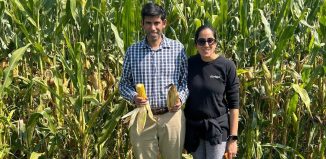CSH’s Zachary Lippman has a taste for tomatoes
Scientist studies wild ancestors of domestic fruit to increase productivity
Going into his tomato project, Zachary Lippman expected something different. After all, over thousands of years, breeders had been growing the juiciest tomatoes they could.
A team of scientists from 14 countries had already put together a genetic blueprint of the 35,000 genes spread across 12 chromosomes for the “Heinz” tomato.
Lippman, meanwhile, led a group of scientists at Cold Spring Harbor, including Richard McCombie and Doreen Ware, to put together a similar genetic blueprint for the naturally occurring wild type. The tomato Lippman studied, which is an edible South American currant tomato, was much more like the original fruit our agricultural ancestors stumbled upon thousands of years ago.
Even before he finished the two-year effort to create his own genetic blueprint, Lippman suspected there would be plenty of genetic differences. After all, corn and rice, among others, had changed a great deal since its domestication.
“The expectation was that we’d see a lot of changes in the DNA,” offered Lippman. “What we found was the opposite. We see a remarkable similarity between the wild and domesticated tomato.”
Indeed, that scientific finding — and the years of work preparing and comparing the genetic libraries of the different tomato types — was flavorful enough for the scientific journal Nature to include it in its most recent issue.
Calling the genetic sequence of the two tomato types a “major first step,” David Spector, Cold Spring Harbor’s research director, explained that this type of research could help identify critical genes that scientists could manipulate to help improve the tomato, in terms of number of flowers that might give more fruit, or its ability to withstand drought conditions or insect infestations.
Longer term, identifying specific genes that could improve the quality and durability of the tomato could have implications for the world’s food supply, suggested Spector.
“Any developments that can be made to help increase yield and resistance to various conditions such as drought or insects will have a huge impact worldwide. What he’s doing is going to have huge global significance. He’s starting with the basics of the sequence of the plant and is working his way up from there.”
Lippman plans to use the information from the genetic sequences of the two tomato types in several ways.
Using classical and modern genetics and breeding technologies, he studies tomato mutants that affect how many flowers are produced by a tomato plant on a branching structure called “inflorescence.” These mutants can cause tomato plants to produce either fewer than normal or more than normal flowers, by changing how many branches are produced on the inflorescence.
He then identifies the genes that are “not working properly” in the mutants and studies how these are turned on and off during growth of the tomato plant. He specifically looks at how these genes change in their activity as the tomato plant transitions from making leaves to making flowers.
He is also crossing wild species that produce a lot of branches and flowers with those that producer fewer flowers. He then “genetically maps” the location of the responsible genes. He studies how these genes change during the reproductive transition and what DNA changes occurred to cause the evolution of the different species that produced different numbers of flowers.
Lippman lives in North Bellmore with his wife Shira, a dentist, and their four children, who range in age from three to nine years old.
Lippman isn’t just a leading expert in the field of tomatoes: he’s also a consummate consumer, carting containers of V8 juice back from trips to Costco.
“It’s not a joke,” he insists. When he’s not working on tomatoes, he likes to eat, or drink, them.
Indeed, his favorite way to eat tomatoes is in a cold tomato salad, with basil and fresh mozzarella, and a pinch of salt and pepper.
Lippman, who was raised in Milford, Conn., first became interested in plants and agriculture, particularly pumpkins and tomatoes, when he took a summer job at Robert Treat Farm, a family-owned farm within a mile of his house.
Lippman hopes large-scale farmers, farm stands and backyard gardeners from around the world will benefit from his research on the genetic sequences and the genes of wild and domesticated tomatoes.






